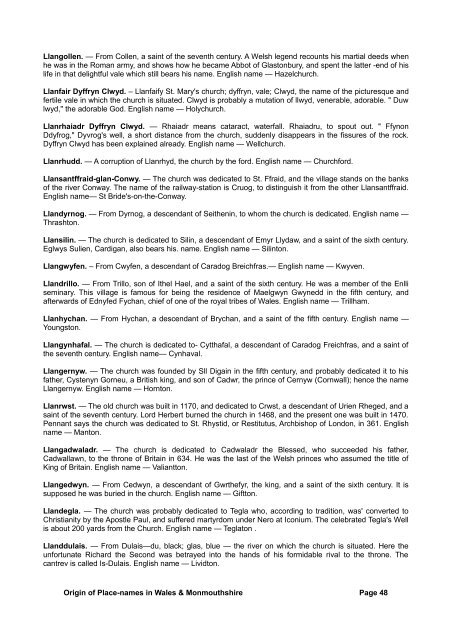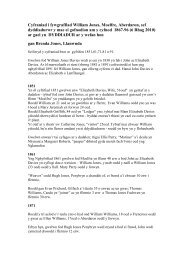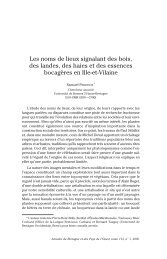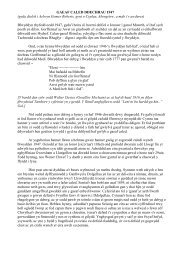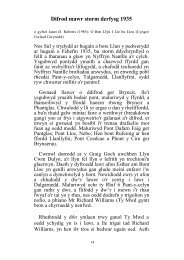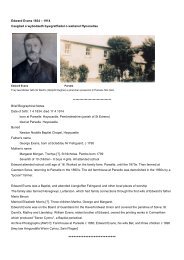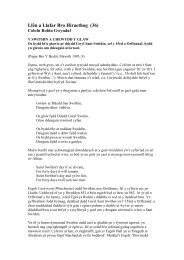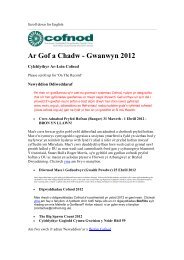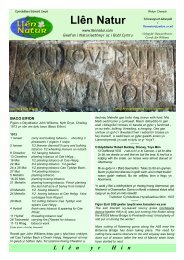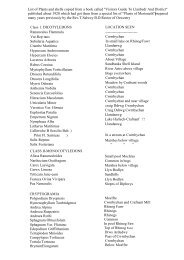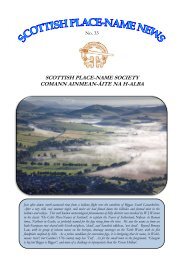hence <strong>the</strong> name <strong>of</strong> <strong>the</strong> <strong>place</strong>. English name— Littlechurch.Esgair Ebrill. — Esg, a shank, a long ridge, that which stretches out; air, bright, clear; Ebrill, April. Englishname— Aprilridge.Efenechtyd. — A corruption <strong>of</strong> y fyneichdyd, <strong>the</strong> monk's l<strong>and</strong>; mynach, monk; dyd or dud, l<strong>and</strong>. Englishname — Monkl<strong>and</strong>.Esclusham. — From esglyw, protection, defence, <strong>and</strong> ham, a <strong>place</strong>. The <strong>place</strong> is <strong>in</strong> close proximity to Offa'sDyke. English name — Dykeham.Fron. — An <strong>in</strong>flection <strong>of</strong> bron, a po<strong>in</strong>ted or breast-shaped hill. English name — Po<strong>in</strong>thill.Ffrwd. — The name means a stream, a torrent. " Ffrwd yr afon," <strong>the</strong> stream <strong>of</strong> <strong>the</strong> river. English name—Streamton.Glynceiriog. — Glyn, a narrow vale; Ceiriog, <strong>the</strong> name <strong>of</strong> <strong>the</strong> river that flows through <strong>the</strong> valley. Englishname — Glenceiriog.Gar<strong>the</strong>n. — From gatrdd<strong>in</strong>, fortified bill, so called from an old British camp <strong>in</strong> <strong>the</strong> <strong>place</strong>. In this <strong>place</strong> Owa<strong>in</strong>Gyfeiliog vanquished <strong>the</strong> Saxons <strong>in</strong> 1161. English name— Forthill.Gresford. — A corruption <strong>of</strong> Groesffordd, so called from its close proximity to an old cross. English name—Crossway.Gwersyllt. — The name signifies a camp or encampment. English name — Campton.Gwy<strong>the</strong>r<strong>in</strong>. — From Sant Gwy<strong>the</strong>r<strong>in</strong>, to whom <strong>the</strong> church was dedicated. He flourished about <strong>the</strong> end <strong>of</strong> <strong>the</strong>sixth century. Gwyth- ve<strong>in</strong>; er<strong>in</strong> gold. English name — Goldton.Gefailrhyd. — Gefail, smithy; rhyd, ford. English name — Smithford,Henllan. — Hen, old; lion, church. A name <strong>of</strong> frequent occurrence <strong>in</strong> Wales. The old church, dedicated to St.Sadwrn, was demolished, <strong>and</strong> re-built <strong>in</strong> 1806. English name— Oldchurch.Holt. — The Norse for wood, or hold <strong>of</strong> wild animals. We f<strong>in</strong>d Berg-holt <strong>in</strong> Essex, which means <strong>the</strong> fortress <strong>in</strong><strong>the</strong> wood. Accord<strong>in</strong>g to Lewis's " Topographical Dictionary," <strong>the</strong> ancient name was Castell Lleon, <strong>the</strong> " castle<strong>of</strong> <strong>the</strong> legions," <strong>and</strong> <strong>the</strong> present name was probably derived from a family <strong>of</strong> <strong>the</strong> name <strong>of</strong> Holt, who are saidto have held <strong>the</strong> castle <strong>in</strong> remote times. English name — Woodby.Llanrhaiadr-yn-Mochnant. — Rhaiadr, waterfall; yn t <strong>the</strong>; mochnant, quick, swift-brook. Accord<strong>in</strong>g to this<strong>in</strong>terpretation, <strong>the</strong> name signifies a church built near <strong>the</strong> swift water. O<strong>the</strong>rs say that mock means sw<strong>in</strong>e, <strong>and</strong>that <strong>the</strong> word nant is applied to <strong>the</strong> whole valley, <strong>in</strong>clusive <strong>of</strong> <strong>the</strong> brook that flows through it, on <strong>the</strong> traditionalbelief that <strong>the</strong> <strong>place</strong> was some time abound<strong>in</strong>g with wild hogs. The latter is <strong>the</strong> more plausible <strong>and</strong>acceptible. English name — Hogham.Llanelian. — From Elian Ge<strong>in</strong>iad, a sa<strong>in</strong>t <strong>of</strong> <strong>the</strong> sixth century, to whom <strong>the</strong> church was * dedicated. Elian'sWell is near <strong>the</strong> village. English name — Elianschurch.Llanegwestl. — From Egwestl, to whom <strong>the</strong> old church was dedicated. E<strong>in</strong>ion Waun alludes to him <strong>in</strong> <strong>the</strong>follow<strong>in</strong>g couplet : —"Gwra wnair fel Gwair fab G west I,Gwyr wawr yn llawr Llanegwestl."English name — Guestham.id est.:-“Like Gwestyl's son, he lies <strong>in</strong> gloom pr<strong>of</strong>oundIn Valle Crucis Abbey's holy ground”.Llanelidan. — The church is dedicated to St. Elidan. English name — Elidan.Orig<strong>in</strong> <strong>of</strong> Place-<strong>names</strong> <strong>in</strong> Wales & Monmouthshire Page 47
Llangollen. — From Collen, a sa<strong>in</strong>t <strong>of</strong> <strong>the</strong> seventh century. A Welsh legend recounts his martial deeds whenhe was <strong>in</strong> <strong>the</strong> Roman army, <strong>and</strong> shows how he became Abbot <strong>of</strong> Glastonbury, <strong>and</strong> spent <strong>the</strong> latter -end <strong>of</strong> hislife <strong>in</strong> that delightful vale which still bears his name. English name — Hazelchurch.Llanfair Dyffryn Clwyd. – Llanfaify St. Mary's church; dyffryn, vale; Clwyd, <strong>the</strong> name <strong>of</strong> <strong>the</strong> picturesque <strong>and</strong>fertile vale <strong>in</strong> which <strong>the</strong> church is situated. Clwyd is probably a mutation <strong>of</strong> llwyd, venerable, adorable. " Duwlwyd," <strong>the</strong> adorable God. English name — Holychurch.Llanrhaiadr Dyffryn Clwyd. — Rhaiadr means cataract, waterfall. Rhaiadru, to spout out. " FfynonDdyfrog," Dyvrog's well, a short distance from <strong>the</strong> church, suddenly disappears <strong>in</strong> <strong>the</strong> fissures <strong>of</strong> <strong>the</strong> rock.Dyffryn Clwyd has been expla<strong>in</strong>ed already. English name — Wellchurch.Llanrhudd. — A corruption <strong>of</strong> Llanrhyd, <strong>the</strong> church by <strong>the</strong> ford. English name — Churchford.Llansantffraid-glan-Conwy. — The church was dedicated to St. Ffraid, <strong>and</strong> <strong>the</strong> village st<strong>and</strong>s on <strong>the</strong> banks<strong>of</strong> <strong>the</strong> river Conway. The name <strong>of</strong> <strong>the</strong> railway-station is Cruog, to dist<strong>in</strong>guish it from <strong>the</strong> o<strong>the</strong>r Llansantffraid.English name— St Bride's-on-<strong>the</strong>-Conway.Ll<strong>and</strong>yrnog. — From Dyrnog, a descendant <strong>of</strong> Sei<strong>the</strong>n<strong>in</strong>, to whom <strong>the</strong> church is dedicated. English name —Thrashton.Llansil<strong>in</strong>. — The church is dedicated to Sil<strong>in</strong>, a descendant <strong>of</strong> Emyr Llydaw, <strong>and</strong> a sa<strong>in</strong>t <strong>of</strong> <strong>the</strong> sixth century.Eglwys Sulien, Cardigan, also bears his. name. English name — Sil<strong>in</strong>ton.Llangwyfen. – From Cwyfen, a descendant <strong>of</strong> Caradog Breichfras.— English name — Kwyven.Ll<strong>and</strong>rillo. — From Trillo, son <strong>of</strong> I<strong>the</strong>l Hael, <strong>and</strong> a sa<strong>in</strong>t <strong>of</strong> <strong>the</strong> sixth century. He was a member <strong>of</strong> <strong>the</strong> Enllisem<strong>in</strong>ary. This village is famous for be<strong>in</strong>g <strong>the</strong> residence <strong>of</strong> Maelgwyn Gwynedd <strong>in</strong> <strong>the</strong> fifth century, <strong>and</strong>afterwards <strong>of</strong> Ednyfed Fychan, chief <strong>of</strong> one <strong>of</strong> <strong>the</strong> royal tribes <strong>of</strong> Wales. English name — Trillham.Llanhychan. — From Hychan, a descendant <strong>of</strong> Brychan, <strong>and</strong> a sa<strong>in</strong>t <strong>of</strong> <strong>the</strong> fifth century. English name —Youngston.Llangynhafal. — The church is dedicated to- Cytthafal, a descendant <strong>of</strong> Caradog Freichfras, <strong>and</strong> a sa<strong>in</strong>t <strong>of</strong><strong>the</strong> seventh century. English name— Cynhaval.Llangernyw. — The church was founded by Sll Diga<strong>in</strong> <strong>in</strong> <strong>the</strong> fifth century, <strong>and</strong> probably dedicated it to hisfa<strong>the</strong>r, Cystenyn Gorneu, a British k<strong>in</strong>g, <strong>and</strong> son <strong>of</strong> Cadwr, <strong>the</strong> pr<strong>in</strong>ce <strong>of</strong> Cernyw (Cornwall); hence <strong>the</strong> nameLlangernyw. English name — Hornton.Llanrwst. — The old church was built <strong>in</strong> 1170, <strong>and</strong> dedicated to Crwst, a descendant <strong>of</strong> Urien Rheged, <strong>and</strong> asa<strong>in</strong>t <strong>of</strong> <strong>the</strong> seventh century. Lord Herbert burned <strong>the</strong> church <strong>in</strong> 1468, <strong>and</strong> <strong>the</strong> present one was built <strong>in</strong> 1470.Pennant says <strong>the</strong> church was dedicated to St. Rhystid, or Restitutus, Archbishop <strong>of</strong> London, <strong>in</strong> 361. Englishname — Manton.Llangadwaladr. — The church is dedicated to Cadwaladr <strong>the</strong> Blessed, who succeeded his fa<strong>the</strong>r,Cadwallawn, to <strong>the</strong> throne <strong>of</strong> Brita<strong>in</strong> <strong>in</strong> 634. He was <strong>the</strong> last <strong>of</strong> <strong>the</strong> Welsh pr<strong>in</strong>ces who assumed <strong>the</strong> title <strong>of</strong>K<strong>in</strong>g <strong>of</strong> Brita<strong>in</strong>. English name — Valiantton.Llangedwyn. — From Cedwyn, a descendant <strong>of</strong> Gwr<strong>the</strong>fyr, <strong>the</strong> k<strong>in</strong>g, <strong>and</strong> a sa<strong>in</strong>t <strong>of</strong> <strong>the</strong> sixth century. It issupposed he was buried <strong>in</strong> <strong>the</strong> church. English name — Giftton.Ll<strong>and</strong>egla. — The church was probably dedicated to Tegla who, accord<strong>in</strong>g to tradition, was' converted toChristianity by <strong>the</strong> Apostle Paul, <strong>and</strong> suffered martyrdom under Nero at Iconium. The celebrated Tegla's Wellis about 200 yards from <strong>the</strong> Church. English name — Teglaton .Ll<strong>and</strong>dulais. — From Dulais—du, black; glas, blue — <strong>the</strong> river on which <strong>the</strong> church is situated. Here <strong>the</strong>unfortunate Richard <strong>the</strong> Second was betrayed <strong>in</strong>to <strong>the</strong> h<strong>and</strong>s <strong>of</strong> his formidable rival to <strong>the</strong> throne. Thecantrev is called Is-Dulais. English name — Lividton.Orig<strong>in</strong> <strong>of</strong> Place-<strong>names</strong> <strong>in</strong> Wales & Monmouthshire Page 48
- Page 1 and 2: HANDBOOK OF THE ORIGIN OF PLACE-NAM
- Page 3 and 4: § § § § §The Author begs to st
- Page 5 and 6: pitiful cries of the railway offici
- Page 7 and 8: Bishop Percy says that "in England,
- Page 9 and 10: The city of Chester is still popula
- Page 11 and 12: There's Cumwhitton, Cumwhinton, Cum
- Page 13 and 14: Llwyn in its primary' sense means a
- Page 15 and 16: PLACE-NAMES IN WALES.Wales. — The
- Page 17 and 18: Church are generally dedicated to e
- Page 19 and 20: think he was a contemporary of St.
- Page 21 and 22: Rhosbeirio. — Rhos, a moor, a dry
- Page 23 and 24: of Brecknock," states that this vic
- Page 25 and 26: Cam cnwir ef Cwmdu,Cwm gwyn yw & n
- Page 27 and 28: Penderyn. — A corruption probably
- Page 29 and 30: Ardudwy. — Ar, upon or above; tud
- Page 31 and 32: to mark its pre-eminence over the o
- Page 33 and 34: Some think that eirw is a corruptio
- Page 35 and 36: present form — Caerfyrddin.Abergw
- Page 37 and 38: place of refuge; hence the name. En
- Page 39 and 40: Llansawyl. — The church was dedic
- Page 41 and 42: eject. The village took its name fr
- Page 43 and 44: house, and attempted to kill an inf
- Page 45 and 46: Gwydir. — Prima facie one may tak
- Page 47 and 48: Nefyn. — The church was probably
- Page 49: DENBIGHSHIRE.Anglicized form of Din
- Page 53 and 54: hands into their pockets to pay a c
- Page 55 and 56: Cefn. — The name signifies a ridg
- Page 57 and 58: Maesgarmon. — Named in honour of
- Page 59 and 60: Abertridwr. — Tridwr, three water
- Page 61 and 62: it is said, was originally built by
- Page 63 and 64: Cwmllynfell. — Cwm, a narrow vale
- Page 65 and 66: Gwarycaeau. — Gwdr, the nape of t
- Page 67 and 68: means a cultivated region, a vale,
- Page 69 and 70: Penrhiwfer.- Pen, head, top; rhiw,
- Page 71 and 72: Port Talbot. — So called in 1835
- Page 73 and 74: Trealaw. — This appellation was g
- Page 75 and 76: Aberdyfi. — So called from its si
- Page 77 and 78: Llanddwywe. — From Dwywau, a desc
- Page 79 and 80: Crickhowell and some in the directi
- Page 81 and 82: Griffithstown. — This village was
- Page 83 and 84: and gwy, water. Treiddiod troth tna
- Page 85 and 86: derive Tintern from din, fortified
- Page 87 and 88: Caersws. — It appears that the Ro
- Page 89 and 90: English name — Ervylton.Llanymech
- Page 91 and 92: Angle. — Probably from the angle-
- Page 93 and 94: Gellyswick. — Another hybrid. Gel
- Page 95 and 96: that the two rivers in their flowin
- Page 97 and 98: ecame the bishop of the see, and wa
- Page 99 and 100: earth formerly stood on a summit on
- Page 101 and 102:
Pilleth. — A corruption of pwll,
- Page 103 and 104:
Howells, Rev. J., Mountain AshHowel
- Page 105 and 106:
Williams, D., PenywernWilliams, Rev


